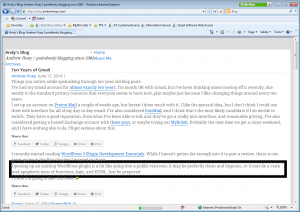When I deleted my PayPal account last week, I had thought that I was only using PayPal for an occasional eBay purchase. I had forgotten that I was also using it to pay for my VPN service, from IPredator. (I didn’t have a recurring payment set up. Rather, I was just paying for it manually, every three months.) IPredator is a fairly small VPN provider in Sweden. They don’t accept credit cards directly, so I’d been paying with PayPal. The only other payment method they accept that would work for me is Payza. I’m not too familiar with them; their terms of service seem to be a bit nicer than PayPal’s, but I’m really not that interested in signing up for a new payment service right now.
I’ve been pretty happy with IPredator, even though it’s a fairly limited service, but those limits, plus the payment issues, have finally gotten me to think more seriously about switching to a different VPN provider. (The main issue was that they only have servers in Sweden, so any time I’m connected to the VPN, it looks like I’m in Sweden.) There are a lot of VPN providers out there, and honestly some of them look a bit shady. After looking around at some reviews, I’ve decided to give Private Internet Access a shot. They only cost $40/year, and are well-supported on Mac, PC, and iOS. They’ve gotten good reviews from Tom’s Hardware and PC Mag. And Ars Technica ran an article about them a while back that makes them look pretty good. They’re pretty highly rated on Torrent Freak too.
So today, I decided to sign up for an account and give them a try. Sign up was simple and easy. They assign a user ID and password to the account and email them to you, in plain text. I think that’s a little iffy, but you can then log in and change the password, so I guess that’s OK.
They have their own client software, for PC, Mac, and iOS, but they also work with standard OpenVPN client software. I initially tried their standard software on my Mac, but it didn’t seem to be working right, and it was a bit ugly. So I installed Viscosity instead. Viscosity works fine, and was easy to set up. I imported two profiles, for US-East and London, and both work.
I then moved from my Mac on to my iOS devices. I skipped the PIA app and went with the OpenVPN app instead. Again, it was pretty easy to get this set up, though the interface for the app is a little weird and has some quirks. But it works.
For my PC, I went with the standard OpenVPN software. The Windows OpenVPN program isn’t quite as simple to use as the iOS app, but it’s easy enough to deal with. You have to manually copy the VPN files into a config folder, and you need to do a little text file editing if you want to save your user name and password, but none of that was a problem for me.
(I should also mention that, at some point, I of course figured out that I could have paid for iPredator through PayPal with a credit card directly, and that I didn’t really need an account. PayPal makes this less than obvious, but the option is there. But by that point I was well on my way to switching to PIA.)
I haven’t used PIA enough yet to comment on their reliability, but I’ll do that at some point after I’ve been using them a while.
